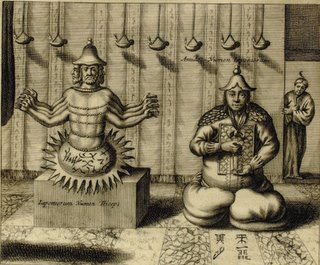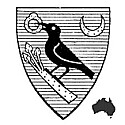..great Kircher, the most miraculous mystagogue of Nature, the great magician..
JS Kestler
JS Kestler











The Jesuit training received by the German arch-polymath, Athanasius Kircher, not only provided the background education from which he was to write some 44 books, it also gave him a strong connection to those missionaries allowed by the church to travel to the exotic lands that so interested Kircher in his studies.
Reports and documents on Tibet, India, China and Japan from other members of the order provided the widely popular renaissance figure with some factual or eye witness material, which Kircher incorporated into his 1667 encyclopedic tome, China Monumentis.
The book was hugely successful, translated and republished many times over and became the fundamental text on Eastern (and particularly Chinese) culture for 2 centuries. It was the first western publication to document the chinese vocabulary and sanskrit alphabet and grammar. It also included accounts of oriental geography, zoology, religion, botany and history. Europeans first heard about the Indian caste system, the Great Wall of China, asbestos, pineapples and other exotic curiosities through Kircher's book.
It was somewhat flawed from the outset however. Kircher had overriding theories that tried to connect back the roots of the Chinese culture to Egypt and Europe wherever possible. His recording of intriguing facts is interspersed with flights of fancy and conjecture based at least in part on mystical beliefs. Still, it stands as an exhaustive treatise that helped promote a better understanding of the Eastern world at the very minimum.
- I nabbed the images here from Max Planck Institute's ECHO project (thumbnail page) There are perhaps another 40 or 50 illustrations in addition to those above.
- This is a list of chapter titles of China monumentis, qua sacris quà profanis, nec non variis naturae & artis spectaculis, aliarumque rerum memorabilium argumentis illustrata ['China, Illustrated Through its Monuments both Sacred and Profane, Together with Numerous Marvels of Nature and Art, and Accounts of other Memorable Matters'] - in latin, leading to another Max Planck digital copy of the book.
- The best images from this book (as I found out/remembered after uploading all of the images here) are at Stanford University - requiring a djvu program. The illustration list is at the bottom of the page. These are chapter titles in english.
- Wikipedia on Athanasius Kircher.
- This is probably the best commentary on the work (online at any rate), by Haun Saussy at City University, Hong Kong.
- A short account of the Sino-Chaldean aspect of Monumentis - depicted above - from the interesting She-Philosopher website.
- A short review of China Monumentis (part way down the page).
- A description of the Idol of 'Fombum' (mis-translation of 'Buddha' apparently) image above.
- This is a 2 page german review of China Monumentis [english translation].
- An alleged translation of Kircher's description of the 'flying cat' depicted above - part way down the page.
- Previous BibliOdyssey posts on Kircher (and I'm sure there will be more).
- Kircher posts at Giornale Nuovo: I, II, III, IV, V.



















1 comment :
The Doshisha University Academic Repository have what seems to be the Dutch version of China Monumentis from 1688 (illustrations are not the best quality - might be age/paper differences).
(and I might be completely wrong - this could be a Dutch review of China travel works - but Kircher is mentioned on the titlepage and I saw a few illustrations that were identical)
Post a Comment
Comments are all moderated so don't waste your time spamming: they will never show up.
If you include ANY links that aren't pertinent to the blog post or discussion they will be deleted and a rash will break out in your underwear.
Also: please play the ball and not the person.
Note: only a member of this blog may post a comment.